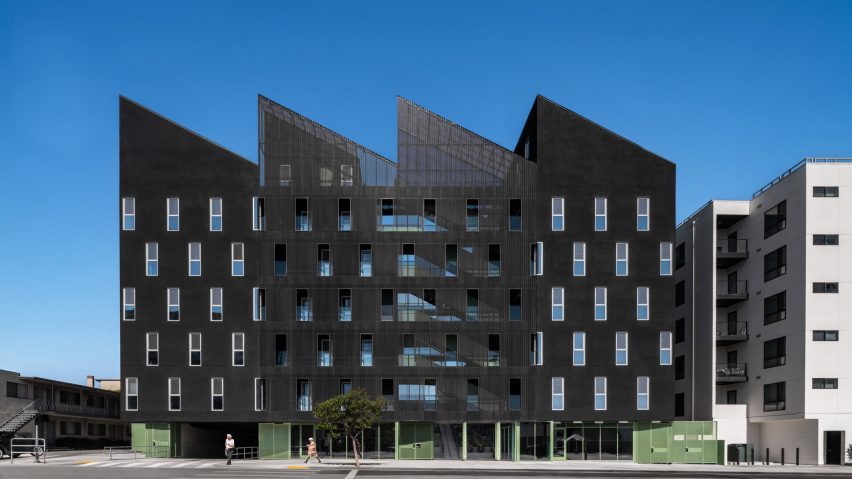Local studio Hopson Rodstrom Design placed a sawtooth roof on top of this black-clad apartment building with an interior courtyard in southern California.
Located in West Los Angeles on a busy thoroughfare, the project is called The Jagger – named after the massive sawtooth roof that tops it.
Pasadena-based studio Hopson Rodstrom Design (H/RD), designed the structure to "embrace" the higher-scale zoning that exists along thoroughfares in areas of the city generally filled with low-lying structures.
It was made possible by the Transit Oriented Communities program in the city.
"West Los Angeles has long been a low-rise and sleepy commercial corridor, but has seen significant growth over the last half-decade," H/RD told Dezeen.
"Since The Jagger began design and construction, another 10 or so projects have sprung up on that same stretch of boulevard."
The seven-storey structure has a ground-level podium clad in green-painted concrete interspersed with steel gates. Along this, gates lead into the complex and into glass-fronted retail and restaurant components.
These aspects are set back slightly from the primary envelope, a massing clad in black-painted plaster with many long windows spread across it.
"The window pattern is based on the maximum allowable percentage of opening along the exterior, broken up into a staggered, offset and repeated pattern around the middle levels of the building," said the studio.
"This enabled every unit to get the maximum allowable amount of light while serving to unify the exterior envelop in an overarching pattern; this pattern in turn contrasts against the changing levels of opacity and materiality in the facade."
These changing levels include a massive screen draped over the middle of the structure.
Made of perforated metal panels fastened to "a rhythm" of vertical steel posts, the screen has multiple functions. It serves as a protective guard for the courtyard staircase, helps maintain the facade, and creates privacy for the interior courtyard.
The screen also allowed the studio to bypass certain height requirements put in place by the city.
"The perforated metal cladding that encases the green exterior stairs on both ends of the courtyard was designed specifically to get the Fire Department to allow an exterior stair to rise higher than six stories, which is the maximum allowed in the code," said the studio.
"We were able to get approval for a 7th story by wrapping the top in the perforated metal."
The interior courtyard is accessed by operable gates at ground level and is "semi-public".
This courtyard has a small footprint at ground level and a concrete stepped feature, covered with planters and transversed by a simple staircase with metal railing.
The staircase leads up to another section covered with planters, and at the far end sits a sculptural staircase painted green that leads to the upper levels.
Office interiors on the ground floor open up to the courtyard via floor-to-ceiling windows.
On one side, the wall of the courtyard going up the height of the structure is interspersed with windows and balconies and on the other are multiple levels of open-air hallways that lead to other apartments.
Because of the courtyard, all the units in the structure have a window to the outside, and the sawtooth-roof was formed to allow for maximum sunlight to enter the courtyard.
It also acts as a "chimney" meant to keep the whole structure cool, according to the studio.
The Jagger was originally part of a larger architectural program by H/RD, with buildings planned for adjacent lots, but one of these lots was ultimately sold and the other similar, barrel-vault-roof building was not built.
Other similar structures that utilise a sawtooth roof include an apartment block in Melbourne by Six Degrees Architects and a mass-timber building in Portland by Lever Architecture.
The photography is by Here and Now Agency (HANA), Paul Vu.
Project credits:
Architect: H/RD; Nick Hopson, Klara Rodstrom, Chris Gassaway, Zach Blaue, Jennifer Bui, Kevin Pazik
Landscape architect: Tina Chee
Structural engineer: Amir Pirbadian
Civil engineer: KPFF
MEP: Henderson
General contractor: Integrare

